7 Specifications
7.1 Absolute Maximum Ratings
over operating free-air temperature range (unless otherwise noted)(1)
|
MIN |
MAX |
UNIT |
| VIN |
Input voltage |
–0.3 |
4 |
V |
| VOUT |
Output voltage |
|
VIN + 0.3 |
V |
| VON |
Input voltage |
–0.3 |
4 |
V |
| PD |
Power dissipation at TA = 25°C |
|
0.48 |
W |
| IMAX |
Maximum continuous switch current |
|
500 |
mA |
| TA |
Operating free-air temperature range |
–40 |
85 |
°C |
| Maximum lead temperature (10-s soldering time), Tlead |
|
300 |
°C |
| Storage temperature, Tstg |
-45 |
150 |
°C |
(1) Stresses beyond those listed under Absolute Maximum Ratings may cause permanent damage to the device. These are stress ratings only, which do not imply functional operation of the device at these or any other conditions beyond those indicated under Recommended Operating Conditions. Exposure to absolute-maximum-rated conditions for extended periods may affect device reliability.
7.2 ESD Ratings
|
VALUE |
UNIT |
| V(ESD) |
Electrostatic discharge |
Human body model (HBM), per ANSI/ESDA/JEDEC JS-001(1) |
±2000 |
V |
| Charged-device model (CDM), per JEDEC specification JESD22-C101(2) |
±1000 |
(1) JEDEC document JEP155 states that 500-V HBM allows safe manufacturing with a standard ESD control process.
(2) JEDEC document JEP157 states that 250-V CDM allows safe manufacturing with a standard ESD control process.
7.3 Recommended Operating Conditions
over operating free-air temperature range (unless otherwise noted)
|
MIN |
MAX |
UNIT |
| VIN |
Input voltage range |
1 |
3.6 |
V |
| VOUT |
Output voltage range |
|
VIN |
V |
| VIH |
High-level input voltage, ON |
0.85 |
3.6 |
V |
| VIL |
Low-level input voltage, ON |
|
0.4 |
V |
| CIN |
Input capacitor |
1 |
|
μF |
7.4 Thermal Information
| THERMAL METRIC(1) |
TPS2206 |
UNIT |
| YZV (DSBGA) |
| 4 PINS |
| RθJA |
Junction-to-ambient thermal resistance |
189.1 |
°C/W |
| RθJC(top) |
Junction-to-case (top) thermal resistance |
1.9 |
°C/W |
| RθJB |
Junction-to-board thermal resistance |
36.8 |
°C/W |
| ψJT |
Junction-to-top characterization parameter |
11.3 |
°C/W |
| ψJB |
Junction-to-board characterization parameter |
36.8 |
°C/W |
| RθJC(bot) |
Junction-to-case (bottom) thermal resistance |
— |
°C/W |
(1) For more information about traditional and new thermal metrics, see the
Semiconductor and IC Package Thermal Metrics application report,
SPRA953.
7.5 Electrical Characteristics
VIN = 1.0 V to 3.6 V, TA = –40°C to 85°C (unless otherwise noted)
| PARAMETER |
TEST CONDITIONS |
TA |
MIN |
TYP |
MAX |
UNIT |
| IIN |
Quiescent current |
IOUT = 0, VIN = VON |
VIN = 1.1 V |
Full |
|
37 |
120 |
nA |
| VIN = 1.8 V |
Full |
|
82 |
235 |
| VIN = 3.6 V |
Full |
|
204 |
880 |
| IIN(OFF) |
OFF-state supply current |
VON = GND, OUT = Open |
VIN = 1.1 V |
Full |
|
22 |
210 |
nA |
| VIN = 1.8 V |
Full |
|
44 |
260 |
| VIN = 3.6 V |
Full |
|
137 |
700 |
| IIN(LEAKAGE) |
OFF-state switch current |
VON = GND, VOUT = 0 |
VIN = 1.1 V |
Full |
|
22 |
140 |
nA |
| VIN = 1.8 V |
Full |
|
45 |
230 |
| VIN = 3.6 V |
Full |
|
137 |
610 |
| rON |
ON-state resistance |
IOUT = - 200 mA |
VIN = 3.6 V |
25°C |
|
90 |
108 |
mΩ |
| Full |
|
|
125 |
| VIN = 2.5 V |
25°C |
|
100 |
120 |
| Full |
|
|
140 |
| VIN = 1.8 V |
25°C |
|
114 |
138 |
| Full |
|
|
160 |
| VIN = 1.2 V |
25°C |
|
172 |
210 |
| Full |
|
|
235 |
| VIN = 1.1 V |
25°C |
|
204 |
330 |
| Full |
|
|
330 |
| rPD |
Output pulldown resistance |
VIN = 3.3 V, VON = 0, IOUT = 30 mA |
25°C |
|
88 |
120 |
Ω |
| ION |
ON input leakage current |
VON = 1.1 V to 3.6 V or GND |
Full |
|
|
25 |
nA |
7.6 Switching Characteristics – VIN = 1.1 V
TA = 25°C , RL_CHIP = 120 Ω (unless otherwise noted)
| PARAMETER |
TEST CONDITIONS |
MIN |
TYP |
MAX |
UNIT |
| tON |
Turnon time |
RL = 500 Ω |
CL = 0.1 μF |
|
531 |
|
μs |
| CL = 1 μF |
|
596 |
|
| CL = 3.3 μF |
|
659 |
|
| tOFF |
Turnoff time |
RL = 500 Ω |
CL = 0.1 μF |
|
11 |
|
μs |
| CL = 1 μF |
|
67 |
|
| CL = 3.3 μF |
|
225 |
|
| tr |
VOUT rise time |
RL = 500 Ω |
CL = 0.1 μF |
|
365 |
|
μs |
| CL = 1 μF |
|
367 |
|
| CL = 3.3 μF |
|
395 |
|
| tf |
VOUT fall time |
RL = 500 Ω |
CL = 0.1 μF |
|
21 |
|
μs |
| CL = 1 μF |
|
189 |
|
| CL = 3.3 μF |
|
565 |
|
7.7 Switching Characteristics – VIN = 1.2 V
TA = 25°C , RL_CHIP = 120 Ω (unless otherwise noted)
| PARAMETER |
TEST CONDITIONS |
MIN |
TYP |
MAX |
UNIT |
| tON |
Turnon time |
RL = 500 Ω |
CL = 0.1 μF |
|
471 |
|
μs |
| CL = 1 μF |
|
527 |
|
| CL = 3.3 μF |
|
587 |
|
| tOFF |
Turnoff time |
RL = 500 Ω |
CL = 0.1 μF |
|
10 |
|
μs |
| CL = 1 μF |
|
61 |
|
| CL = 3.3 μF |
|
199 |
|
| tr |
VOUT rise time |
RL = 500 Ω |
CL = 0.1 μF |
|
324 |
|
μs |
| CL = 1 μF |
|
325 |
|
| CL = 3.3 μF |
|
350 |
|
| tf |
VOUT fall time |
RL = 500 Ω |
CL = 0.1 μF |
|
20 |
|
μs |
| CL = 1 μF |
|
175 |
|
| CL = 3.3 μF |
|
523 |
|
7.8 Switching Characteristics – VIN = 1.8 V
TA = 25°C , RL_CHIP = 120 Ω (unless otherwise noted)
| PARAMETER |
TEST CONDITIONS |
MIN |
TYP |
MAX |
UNIT |
| tON |
Turnon time |
RL = 500 Ω |
CL = 0.1 μF |
|
302 |
|
μs |
| CL = 1 μF |
|
335 |
|
| CL = 3.3 μF |
|
367 |
|
| tOFF |
Turnoff time |
RL = 500 Ω |
CL = 0.1 μF |
|
8 |
|
μs |
| CL = 1 μF |
|
49 |
|
| CL = 3.3 μF |
|
167 |
|
| tr |
VOUT rise time |
RL = 500 Ω |
CL = 0.1 μF |
|
220 |
|
μs |
| CL = 1 μF |
|
220 |
|
| CL = 3.3 μF |
|
235 |
|
| tf |
VOUT fall time |
RL = 500 Ω |
CL = 0.1 μF |
|
15 |
|
μs |
| CL = 1 μF |
|
159 |
|
| CL = 3.3 μF |
|
481 |
|
7.9 Switching Characteristics – VIN = 2.5 V
TA = 25°C , RL_CHIP = 120 Ω (unless otherwise noted)
| PARAMETER |
TEST CONDITIONS |
MIN |
TYP |
MAX |
UNIT |
| tON |
Turnon time |
RL = 500 Ω |
CL = 0.1 μF |
|
223 |
|
μs |
| CL = 1 μF |
|
246 |
|
| CL = 3.3 μF |
|
268 |
|
| tOFF |
Turnoff time |
RL = 500 Ω |
CL = 0.1 μF |
|
7 |
|
μs |
| CL = 1 μF |
|
47 |
|
| CL = 3.3 μF |
|
158 |
|
| tr |
VOUT rise time |
RL = 500 Ω |
CL = 0.1 μF |
|
175 |
|
μs |
| CL = 1 μF |
|
175 |
|
| CL = 3.3 μF |
|
187 |
|
| tf |
VOUT fall time |
RL = 500 Ω |
CL = 0.1 μF |
|
18 |
|
μs |
| CL = 1 μF |
|
185 |
|
| CL = 3.3 μF |
|
471 |
|
7.10 Switching Characteristics – VIN = 3 V
TA = 25°C , RL_CHIP = 120 Ω (unless otherwise noted)
| PARAMETER |
TEST CONDITIONS |
MIN |
TYP |
MAX |
UNIT |
| tON |
Turnon time |
RL = 500 Ω |
CL = 0.1 μF |
|
191 |
|
μs |
| CL = 1 μF |
|
211 |
|
| CL = 3.3 μF |
|
231 |
|
| tOFF |
Turnoff time |
RL = 500 Ω |
CL = 0.1 μF |
|
7 |
|
μs |
| CL = 1 μF |
|
46 |
|
| CL = 3.3 μF |
|
156 |
|
| tr |
VOUT rise time |
RL = 500 Ω |
CL = 0.1 μF |
|
159 |
|
μs |
| CL = 1 μF |
|
160 |
|
| CL = 3.3 μF |
|
170 |
|
| tf |
VOUT fall time |
RL = 500 Ω |
CL = 0.1 μF |
|
17 |
|
μs |
| CL = 1 μF |
|
160 |
|
| CL = 3.3 μF |
|
473 |
|
7.11 Switching Characteristics – VIN = 3.6 V
TA = 25°C , RL_CHIP = 120 Ω (unless otherwise noted)
| PARAMETER |
TEST CONDITIONS |
MIN |
TYP |
MAX |
UNIT |
| tON |
Turnon time |
RL = 500 Ω |
CL = 0.1 μF |
|
166 |
|
μs |
| CL = 1 μF |
|
183 |
|
| CL = 3.3 μF |
|
201 |
|
| tOFF |
Turnoff time |
RL = 500 Ω |
CL = 0.1 μF |
|
7 |
|
μs |
| CL = 1 μF |
|
45 |
|
| CL = 3.3 μF |
|
155 |
|
| tr |
VOUT rise time |
RL = 500 Ω |
CL = 0.1 μF |
|
146 |
|
μs |
| CL = 1 μF |
|
146 |
|
| CL = 3.3 μF |
|
156 |
|
| tf |
VOUT fall time |
RL = 500 Ω |
CL = 0.1 μF |
|
17 |
|
μs |
| CL = 1 μF |
|
161 |
|
| CL = 3.3 μF |
|
475 |
|
7.12 Typical Characteristics
 Figure 1. rON vs VIN
Figure 1. rON vs VIN
 Figure 3. Voltage Drop vs Load Current
Figure 3. Voltage Drop vs Load Current
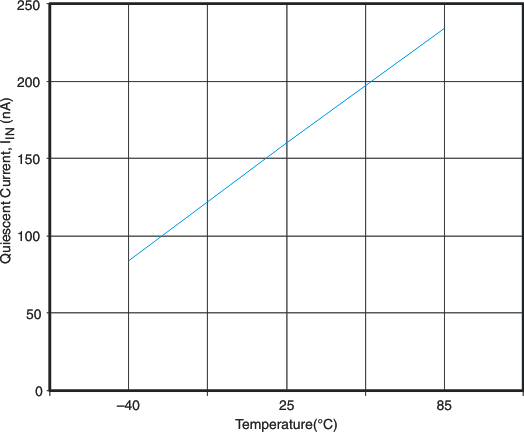 Figure 5. Quiescent Current vs Temperature
Figure 5. Quiescent Current vs Temperature 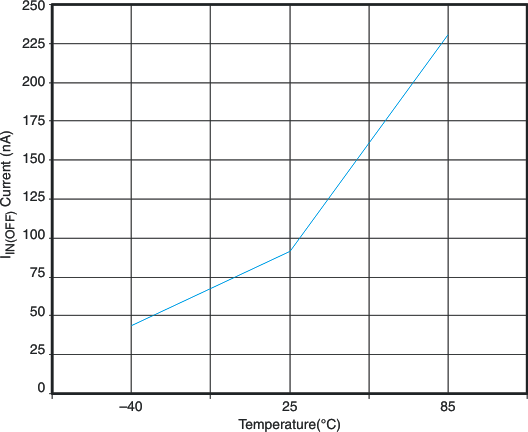 Figure 7. IIN(OFF) vs Temperature (VIN = 3.3 V)
Figure 7. IIN(OFF) vs Temperature (VIN = 3.3 V)
 Figure 9. IIN (Leakage) vs Temperature (VIN = 3.3 V)
Figure 9. IIN (Leakage) vs Temperature (VIN = 3.3 V)
 Figure 11. trise/tfall vs Temperature
Figure 11. trise/tfall vs Temperature
 Figure 13. tON Response
Figure 13. tON Response
 Figure 15. tON Response
Figure 15. tON Response
 Figure 17. tON Response
Figure 17. tON Response
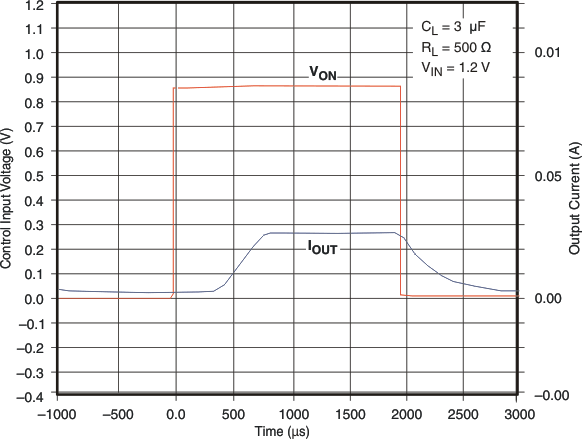 Figure 19. tON Response
Figure 19. tON Response
 Figure 21. tOFF Response
Figure 21. tOFF Response
 Figure 23. tOFF Response
Figure 23. tOFF Response
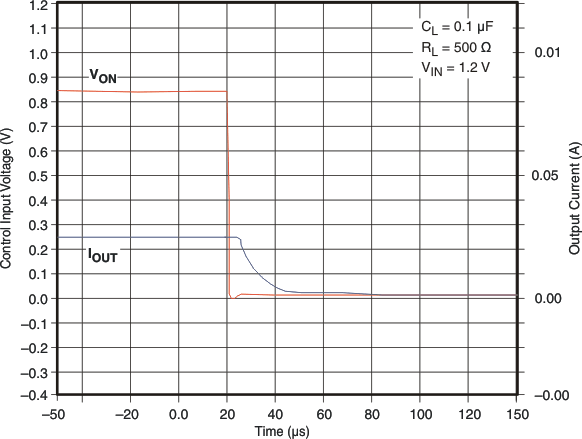 Figure 25. tOFF Response
Figure 25. tOFF Response
 Figure 27. tOFF Response
Figure 27. tOFF Response
 Figure 2. rON vs Temperature (VIN = 3.3 V)
Figure 2. rON vs Temperature (VIN = 3.3 V)
 Figure 4. Quiescent Current vs VIN (VON = VIN, IOUT = 0)
Figure 4. Quiescent Current vs VIN (VON = VIN, IOUT = 0)
 Figure 6. IIN(OFF) vs VIN (VON = 0 V)
Figure 6. IIN(OFF) vs VIN (VON = 0 V)
 Figure 8. IIN(Leakage) vs VIN (IOUT = 0)
Figure 8. IIN(Leakage) vs VIN (IOUT = 0)
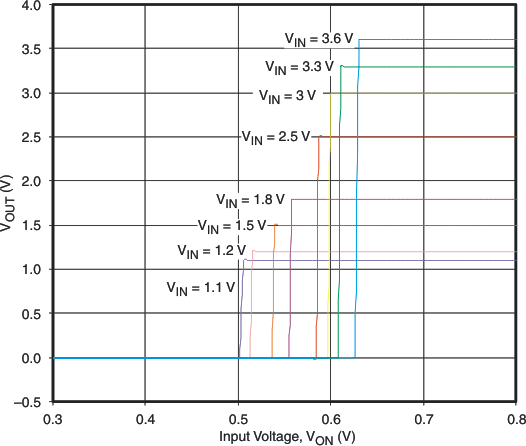 Figure 10. ON-Input Threshold
Figure 10. ON-Input Threshold
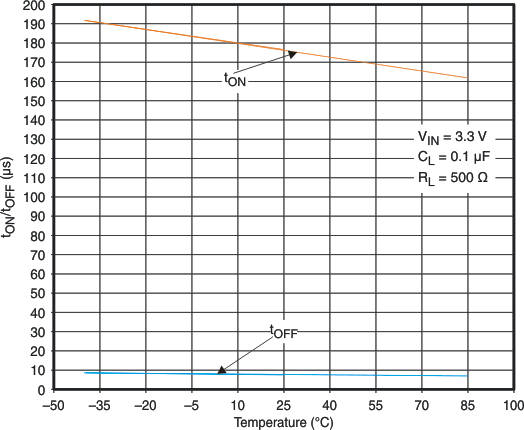 Figure 12. tON/tOFF vs Temperature
Figure 12. tON/tOFF vs Temperature
 Figure 14. tON Response
Figure 14. tON Response
 Figure 16. tON Response
Figure 16. tON Response
 Figure 18. tON Response
Figure 18. tON Response
 Figure 20. tON Response
Figure 20. tON Response
 Figure 22. tOFF Response
Figure 22. tOFF Response
 Figure 24. tOFF Response
Figure 24. tOFF Response
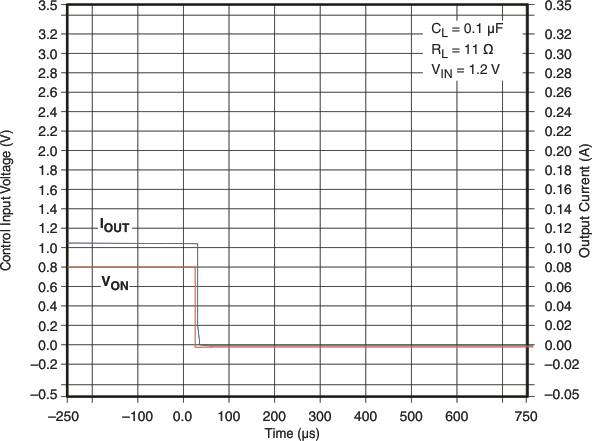 Figure 26. tOFF Response
Figure 26. tOFF Response
 Figure 28. tOFF Response
Figure 28. tOFF Response